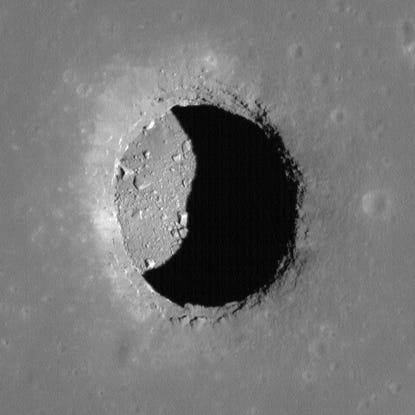In a groundbreaking discovery, scientists have found compelling evidence of an underground cave on the moon, which could potentially serve as a safe and habitable environment for astronauts. This finding marks a significant milestone in the ongoing quest to establish a permanent human presence on the lunar surface. The discovery, detailed in a recent paper by a team of Italian researchers, suggests that there may be hundreds of such caves hidden beneath the moon’s surface. Scientists find a moon cave for astronauts and believe others exist

The Discovery and Its Implications
For years, scientists have speculated about the existence of underground caves on the moon. Now, thanks to radar technology and data from NASA’s Lunar Reconnaissance Orbiter, researchers have identified a large cave situated within the Mare Tranquillitatis pit. This pit likely formed when a lava tube collapsed, creating a vast underground cavity. The cave is estimated to be about 150 feet wide and up to 260 feet long, slightly smaller than an American football field. The discovery is particularly exciting because these caves could provide a stable and protective environment for astronauts. Unlike the moon’s surface, which experiences extreme temperature fluctuations and high radiation levels, the interior of these caves would offer consistent temperatures and natural shielding from radiation. According to Katherine Joy, a professor of earth sciences at the University of Manchester, “The thick cave ceiling of rock is ideal to protect people and infrastructure from the wildly varying day-night lunar surface temperature variations and to block high-energy radiation.”
The Formation and Exploration of Lunar Caves
The moon’s surface is dotted with lava tubes, remnants of volcanic activity from billions of years ago. Over time, some of these tubes have collapsed, creating pits and potential cave entrances. Radar images have identified over 200 of these pits, suggesting that many more caves could exist beneath the lunar surface. These caves could revolutionize moon missions by providing natural shelters for astronauts, making the construction of surface habitats unnecessary. However, accessing these caves presents its own set of challenges. The Mare Tranquillitatis cave, for example, is located over 400 feet from the surface, at the bottom of a steep slope filled with loose debris. Innovative technologies, such as jet packs or lunar elevators, would be required to transport astronauts in and out of these pits safely.
Exploring these caves could yield valuable scientific data and resources for future space missions. Radar technology could help map the interior of these caves, identifying the best locations for future lunar bases. Additionally, these caves might harbor water ice, a crucial resource for any sustained lunar presence. Water could be used for drinking, as well as broken down into hydrogen for rocket fuel and oxygen for breathing.
The Future of Lunar Exploration
The discovery of this moon cave opens up exciting possibilities for future lunar exploration. Scientists believe that these caves could serve as fossilized records of the moon’s volcanic history, providing insights into its geological past. Moreover, the presence of water ice in these caves could support not only lunar bases but also missions to Mars and beyond. Scientists find a moon cave for astronauts and believe others exist As researchers continue to explore and map the moon surface, the identification of more caves could significantly impact NASA’s plans for a permanent human presence on the moon. By utilizing these natural shelters, astronauts could be protected from the harsh lunar environment, making long-term habitation more feasible.
The discovery of an underground cave on the moon represents a significant step forward in our understanding of the lunar surface and its potential for human habitation. With further exploration and technological advancements, these caves could become key components of future lunar missions, providing safe havens for astronauts and valuable resources for sustaining human life beyond Earth.
For further information, visit: https://www.slashgear.com/1583425/innovative-new-technologies-nasa-is-exploring/?zsource=msnsyndicated
Read our previous articles: https://scitechupdate.com/index.php/researchers-develop-biocomputer-by-linking-16-brain-like-structures-grown-from-human-cells/
Breakthrough Material: NASA’s GRX-810 Could Change Everything (scitechupdate.com)
First 5G-enabled Surgery performed by Doctor (scitechupdate.com)
Hitchhiking Aliens: New Research into Panspermia (scitechupdate.com)
Two new COVID variants, called ‘FLiRT’ in the United States (scitechupdate.com)
Sex and Gender Studies: Unlocking Equality and Social Justice (scitechupdate.com)
https://scitechupdate.com/index.php/israel-advances-cancer-treatment-with-genomic-profiling/https://scitechupdate.com/index.php/stomach-cancer-causes-signs-and-treatment/
